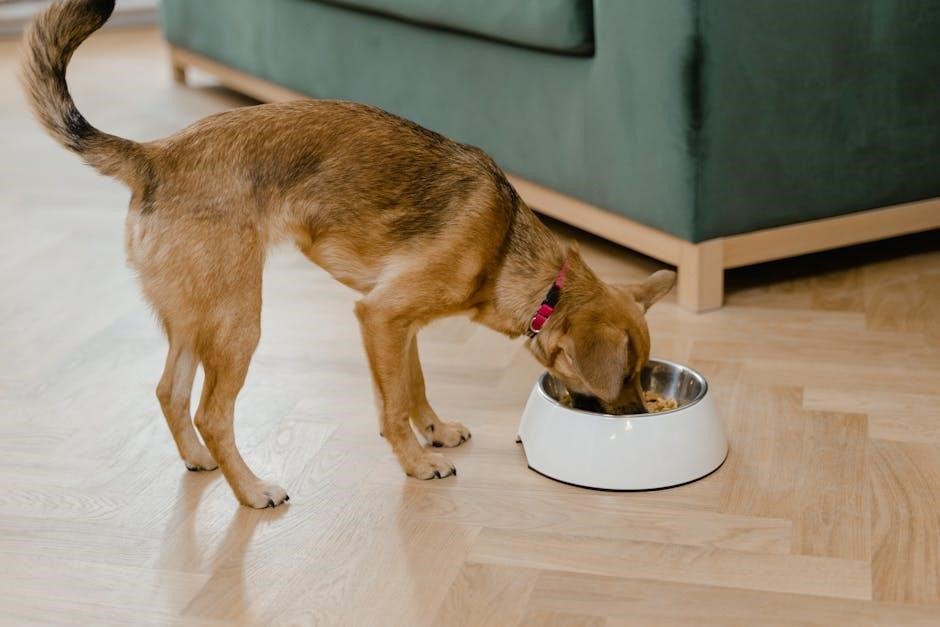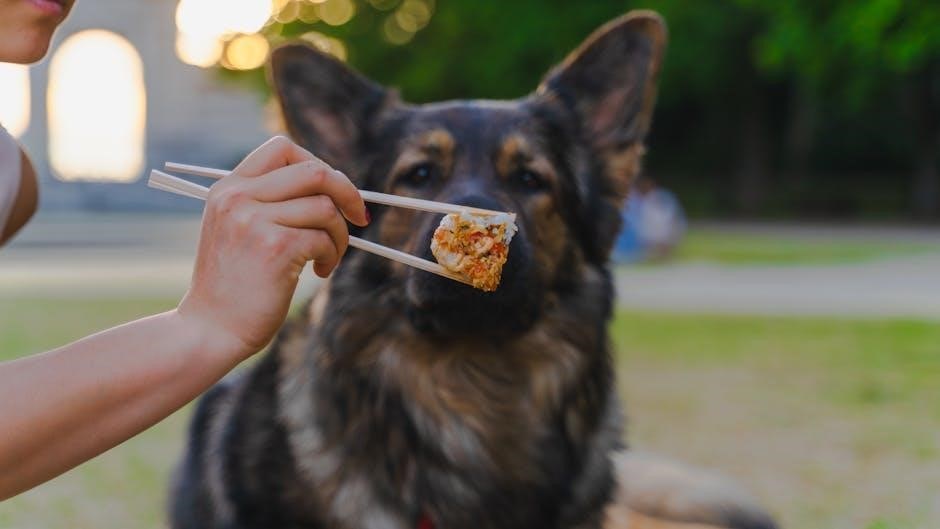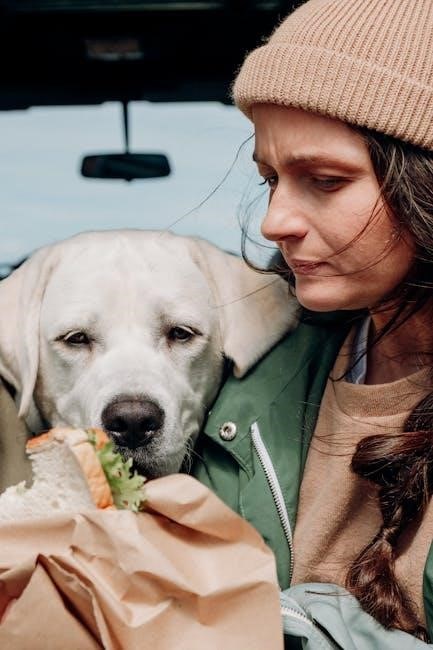cesar dog food feeding guide

cesar dog food feeding guide
The Cesar Dog Food Feeding Guide is essential for pet owners seeking balanced nutrition for their dogs. It provides tailored recommendations to ensure optimal health and vitality‚ addressing specific dietary needs across different life stages and activity levels. This guide helps dog owners make informed decisions‚ ensuring their pets receive the right amount of nutrients for a happy and healthy life.
Understanding Cesar Dog Food Products
Cesar Dog Food offers a variety of products‚ including wet food‚ dry kibble‚ and treats‚ catering to different life stages and dietary needs. High-quality ingredients ensure…
2.1 Types of Cesar Dog Food
Cesar Dog Food offers a variety of options to cater to different dietary needs and preferences. Their product line includes wet dog food‚ dry kibble‚ and delicious treats. Wet food comes in convenient trays or cans‚ providing moisture-rich meals that many dogs find appealing. Dry food‚ on the other hand‚ is ideal for maintaining dental health and can be stored for longer periods. Treats are perfect for training or rewarding your pet‚ offering a tasty snack without compromising nutrition. Cesar also provides grain-free and limited-ingredient options for dogs with sensitivities. Each product is formulated to meet specific life stages‚ such as puppy‚ adult‚ or senior‚ ensuring tailored nutrition for every dog’s needs.
2.2 Nutritional Profile of Cesar Dog Food
Cesar Dog Food is formulated to provide a balanced and complete diet for dogs‚ meeting their essential nutritional needs. It contains high-quality protein sources like chicken or beef‚ which are vital for muscle maintenance and energy. The food also includes whole grains‚ vitamins‚ and minerals to support overall health. Cesar Dog Food is enriched with antioxidants to boost the immune system and omega fatty acids for healthy skin and coat. The recipes avoid fillers‚ ensuring that each meal is nutrient-dense. Additionally‚ Cesar offers grain-free options for dogs with dietary sensitivities. The food is designed to meet the nutritional standards set by regulatory bodies‚ ensuring pets receive the necessary nutrients for optimal health at every life stage.
Cesar Dog Food Feeding Charts
Cesar Dog Food Feeding Charts provide precise feeding recommendations based on a dog’s weight‚ age‚ and activity level‚ ensuring optimal nutrition and preventing underfeeding or overfeeding for a healthy lifestyle.
3.1 Feeding Guidelines for Puppies
Feeding guidelines for puppies are crucial to support their rapid growth and development. Puppies require nutrient-rich meals to fuel their energy needs and build strong immune systems. Cesar Dog Food offers tailored feeding plans for puppies‚ ensuring they receive the right balance of proteins‚ vitamins‚ and minerals. Typically‚ puppies need to be fed 3-4 times daily until they are about six months old‚ after which they can transition to twice a day. It’s important to monitor their weight and adjust portions to prevent underfeeding or overfeeding. Gradually introducing adult dog food around 12 months can help ensure a smooth transition. Always consult a veterinarian to customize feeding plans based on breed‚ size‚ and individual health conditions.
3.2 Feeding Guidelines for Adult Dogs
Adult dogs require a balanced diet to maintain their health and energy levels. Cesar Dog Food provides a variety of flavors and textures tailored to adult dogs‚ ensuring they receive essential nutrients. Feeding guidelines recommend offering meals twice daily‚ with portion sizes adjusted based on the dog’s size‚ breed‚ and activity level. Monitoring your dog’s weight and adjusting food intake can help prevent obesity. It’s important to avoid overfeeding‚ as adult dogs may gain weight more easily. Cesar Dog Food is formulated to meet the nutritional needs of adult dogs‚ promoting a healthy coat‚ strong muscles‚ and overall well-being. Always ensure fresh water is available‚ and consider any specific dietary needs or restrictions recommended by your veterinarian.
3.3 Feeding Guidelines for Senior Dogs
As dogs age‚ their dietary needs evolve‚ requiring a focus on maintaining joint health‚ digestion‚ and weight management. Cesar Dog Food offers senior-specific formulas designed to address these needs. Feeding guidelines suggest adjusting portion sizes based on the dog’s reduced activity level and metabolism. Senior dogs may benefit from smaller‚ more frequent meals to aid digestion. It’s crucial to monitor their weight to prevent obesity‚ which can exacerbate age-related health issues. Cesar Dog Food for seniors is formulated with ingredients that support mobility and overall health. Always consult your veterinarian to tailor feeding plans to your dog’s specific health conditions. Ensuring access to fresh water and a balanced diet will help promote a healthy and comfortable golden age for your furry companion.

Factors Affecting Feeding Needs
Several factors influence a dog’s feeding requirements‚ such as age‚ size‚ breed‚ and activity level. Puppies‚ adult dogs‚ and seniors have differing nutritional needs due to varying energy levels and physiological demands. A dog’s weight and body condition also play a role‚ as overweight dogs may require portion control to prevent health issues. Additionally‚ health conditions‚ such as allergies or mobility problems‚ can necessitate specialized diets. Active dogs or those engaged in regular exercise may need more calories to sustain their energy levels. Breed-specific traits‚ like larger dogs needing joint support‚ further tailor feeding requirements. Monitoring these factors ensures the dog receives a balanced and appropriate diet‚ promoting overall health and well-being. Consulting a veterinarian can provide personalized recommendations based on these unique needs.
How to Measure and Transition to Cesar Dog Food
Measuring your dog’s food accurately is crucial to avoid overfeeding or underfeeding. Use a standard measuring cup and refer to the feeding guide on the Cesar Dog Food packaging for portion sizes. When transitioning your dog to Cesar Dog Food‚ introduce it gradually to prevent digestive upset. Start by mixing a small amount of Cesar with their current food‚ increasing the proportion over 7-10 days until the transition is complete. Monitor your dog’s weight‚ energy levels‚ and stool quality during this process. Adjust portions as needed based on individual needs. Always ensure fresh water is available to keep your dog hydrated. A smooth transition ensures your dog adapts well to the new diet‚ maximizing the benefits of Cesar Dog Food.
Common Feeding Mistakes to Avoid
When feeding your dog Cesar Dog Food‚ there are several common mistakes to avoid for optimal health. Overfeeding is a prevalent error‚ as it can lead to obesity and related health issues. Underfeeding‚ on the other hand‚ may result in malnutrition. Another mistake is mixing Cesar Dog Food with lower-quality brands‚ which can dilute its nutritional benefits. Feeding your dog table scraps or human food regularly can disrupt their balanced diet and lead to digestive problems. Additionally‚ some owners fail to adjust portion sizes based on their dog’s life stage‚ activity level‚ or weight changes. Skipping vet consultations to confirm dietary needs is also a mistake. By adhering to the feeding guide and avoiding these errors‚ you can ensure your dog receives the proper nutrition for a healthy and thriving life.
Health Considerations When Feeding Cesar Dog Food
Feeding Cesar Dog Food requires attention to your dog’s health needs to ensure optimal wellness. It’s crucial to avoid feeding human foods that are toxic to dogs‚ such as chocolate or onions‚ as they can cause severe health issues. Allergies or sensitivities to certain ingredients in Cesar Dog Food should be monitored‚ and adjustments made if symptoms arise. Proper hydration is essential‚ so always provide fresh water alongside meals. Overfeeding can lead to obesity‚ which increases the risk of diabetes and joint problems. Regular vet check-ups are vital to assess your dog’s weight‚ digestive health‚ and overall condition. Additionally‚ dogs with pre-existing health conditions may require tailored diets‚ so consulting a veterinarian before switching or continuing with Cesar Dog Food is recommended. By addressing these health considerations‚ you can help your dog thrive on a Cesar Dog Food diet.

Cost Considerations and Budgeting
When planning your dog’s diet with Cesar Dog Food‚ it’s important to consider the cost implications. The price varies based on the size and breed of your dog‚ as larger breeds require more food. Budgeting is crucial to ensure consistency in feeding without financial strain. Cesar Dog Food is generally affordable compared to premium brands‚ but long-term use can add up. To manage costs‚ consider bulk purchases or subscribing for regular deliveries‚ which often come with discounts. Additionally‚ avoid overfeeding‚ as it not only harms your dog’s health but also wastes money. Balancing quality and cost is key‚ ensuring your dog gets the nutrients they need without exceeding your budget. Planning ahead and monitoring expenses can help maintain a sustainable feeding routine for your pet.

DIY vs Store-Bought: Choosing the Right Option
When deciding between DIY and store-bought dog food‚ consider your dog’s specific needs and your lifestyle. DIY diets allow customization but require careful planning to ensure nutritional balance. Store-bought options like Cesar Dog Food offer convenience and consistency‚ with formulations tailored to different life stages and dietary needs. DIY meals can be cost-effective but risk nutritional deficiencies if not properly balanced. Store-bought foods are pre-formulated to meet standards‚ ensuring your dog gets essential nutrients. Ultimately‚ the choice depends on your time‚ expertise‚ and budget. For many pet owners‚ a combination of both—using store-bought as a base and adding occasional homemade treats—provides a practical solution. Always consult a veterinarian before making significant changes to your dog’s diet to ensure it meets their health requirements.
Storage Tips for Cesar Dog Food
Proper storage of Cesar Dog Food is crucial to maintain its freshness and nutritional value. Store dry food in a cool‚ dry place‚ away from direct sunlight and moisture. Use an airtight container to keep it fresh and prevent pests. For wet food‚ keep it refrigerated after opening and consume within a few days. Always check the expiration date before feeding. Rotate your stock to ensure older packages are used first. Avoid storing dog food in humid or hot environments‚ as this can lead to spoilage. Clean storage containers regularly to prevent contamination. By following these tips‚ you can ensure your dog enjoys high-quality‚ fresh meals every time. Always refer to the packaging for specific storage instructions from the manufacturer.

Hydration and Treats: Additional Considerations
Hydration is vital for your dog’s health‚ so ensure fresh water is always available. Monitor water intake‚ especially in hot weather or for active dogs. Treats can be a great way to reward or train your dog‚ but choose healthy options to avoid overfeeding. Opt for low-calorie‚ nutrient-rich treats and avoid giving table scraps‚ as they can lead to weight gain or digestive issues. Introduce new treats slowly to prevent upset stomachs. Consider your dog’s dietary needs and allergies when selecting treats. Always check the ingredient list to ensure they align with your dog’s overall diet. Balance is key to maintaining a healthy and happy pet. Treats should not exceed 10% of your dog’s daily calorie intake to prevent obesity and other health problems.